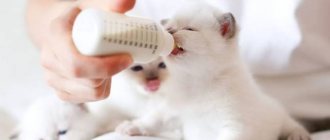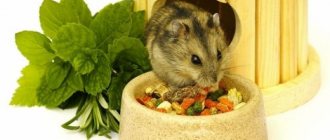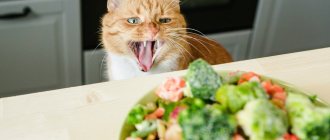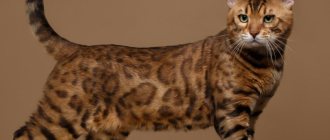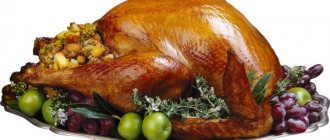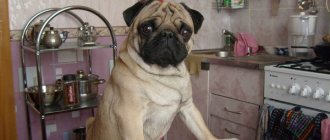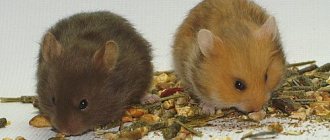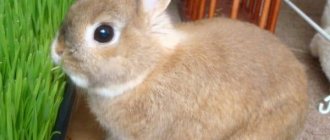Feeding a cat is not a difficult task.
Your pet doesn’t need culinary masterpieces: just make sure you have the correct ratio of proteins, carbohydrates, minerals and vitamins.
But knowing only about the proper nutrition of cats is not enough - it is important to remember which foods are strictly prohibited for cats.
Features of structure and natural nutrition
Felines naturally eat animal foods. Meat forms the basis of their diet. Only some species of wild cats eat fish and bird eggs. They are exclusively an addition to the diet and help diversify it.
Cats do not synthesize enzymes in their digestive tract that digest plant foods. The predator obtains all the substances produced by plants by eating the herbivore’s stomach. It contains plant residues that have already been processed with the necessary enzymes.
In rare cases, a cat will feast on plants. She does this in order to cleanse the intestines of hairballs and small undigested remains - skins, bones, feathers, claws. Some processes and feeding skills are “recorded” in domestic carnivores at the genetic level, while others they master during the learning process.
Therefore, the eating habits of pets are somewhat different from their counterparts living in the wild. It is believed that the cat will not eat harmful and spoiled foods. However, street animals eat in garbage dumps, and the food there is not the freshest. It’s true that such animals live 5 times less than pets.
In order for your pet to live as long as possible and have excellent health, its diet must meet certain requirements and consist only of healthy foods.
Kitten feeding regimen
First, it is important to understand WHEN to introduce complementary foods and how often to feed the kitten. You, of course, can be guided by the kitten's hungry look, but it is better not to awaken the beast in him, and 3-4 weeks after birth, begin to gradually feed the baby.
By 4 weeks of age, a stable eating schedule should be established.
The baby should receive additional feeding 4-7 times a day.
But there are stalemate situations when kittens need additional feeding much more often.
How many times a day should you feed your kitten?
- age up to 2 weeks – 10 times a day (with night coverage);
- feeding a one-month-old kitten – 8 times a day (including the night);
- 1 - 2 months - 7 times a day (night is already excluded);
- 2 - 3 months - 6 times a day;
- 4 months - 5 months - 5 times a day;
- 5 - 9 months - 4 times a day;
- 9 - 12 months - 3 times a day;
- Feeding kittens from 1 year of age becomes twice a day (for example, 9:00 – 21:00).
How much food to give a kitten:
- Age 1 week – 30 ml per 100 g of kitten weight;
- 2 weeks – 38 ml per 100 g of kitten’s weight;
- 3 weeks – 48 ml per 100 g of kitten’s weight;
- 4 weeks and subsequent – 48-53 ml per 100 grams of kitten weight.
How much food should a kitten receive per day?
Of course, it’s easy to calculate the amount of feed based on the items already proposed, but we’ll make the task easier and give a few numbers:
- At 1.5 months, a baby needs about 120 grams of food per day;
- We feed a two-month-old kitten more - 160-180 grams per day;
- During the period of active growth (3 months - 6 months), the daily food intake is 180-240 grams, with at least 40 grams of meat;
- A six-month-old baby needs up to 180 grams of food per day;
- At 10-12 months, the period when the kitten’s activity decreases, the daily food intake is 150-200 grams.
Meat and offal
They are the basis of the diet and should make up 40-60% of the daily portion. Preference should be given to raw meat, since the cat’s gastrointestinal tract has all the necessary enzymes for its digestion and absorption. Fresh meat satisfies natural instincts, cleanses and strengthens teeth, and provides the body with healthy proteins.
Some albumins needed by the cat's body are not synthesized in the body, like in other carnivores. Therefore, the diet of a domestic cat should contain 2 times more animal proteins than, for example, dogs. But some types of meat and offal can pose a health risk to your domestic cat.
Fatty meats - pork, lamb - cause excess cholesterol, which causes atherosclerosis and heart disease. Thermally untreated meat may contain helminth eggs, toxins, and pathogens. Therefore, it needs to be frozen or boiled.
But proteins denatured under the influence of high temperature cannot fully ensure the processes of tissue synthesis. Preference should be given to frozen or tested fresh meat.
By-products are no less valuable for the cat’s body. Giblets are divided into 2 categories:
- The first includes the liver, kidneys, tongue, brains, and heart. In terms of the amount of protein they are not inferior to meat, they contain little fat and are easily digestible. They are subject to the same processing as meat and can replace it.
- The second category is the stomach, trachea, heads, ears, lungs, legs, tails. They are less valuable, but there are much more of them in finished feeds than category 1 by-products. After boiling, they can also be added to the cat’s food. However, you shouldn’t get carried away with them, despite their cheapness.
The liver and kidneys are natural filters, and their tissues accumulate toxins, antibiotics, and growth hormones, which are used in breeding poultry and livestock. They cause digestive disorders, diarrhea, and allergies.
They are light, contain little fat, and are not inferior in protein to veal tenderloin. Cats happily eat lungs, but if there is dysfunction of the joints, a tendency to dysplasia and salt deposition (gout), they and other by-products should not be given to the animal. They cause progression of the disease. For old animals, the amount of by-products should be limited as much as possible or eliminated altogether, especially liver.
Ready-made food for kittens
What is better to feed kittens - dry food or natural food? The question is complex. To feed a kitten with ready-made food or not to feed it – Shakespearean passions have been in full swing for many years. Probably, if we assume that good and responsible producers have put all the necessary microelements, minerals, vitamins and additives in a jar or bag of food, then feeding with ready-made food has its place, moreover, it makes life easier for the kitten’s owner. And reviews from veterinarians about such feeding at home are positive.
But if you choose this light option, you simply must learn a few important rules:
- The main rule is called “Either-or”. Either ready-made food or natural feeding. You can't mix. Not at all. Not even a drop! Natural food and prepared food are digested differently. The first is absorbed without drinking a lot, and the digestion of dry food requires a lot of moisture, without which enzymolysis does not begin. If you change the types of food, then the kitten’s stomach and intestines will not have time to rebuild and as a result - hello, gastroenteritis, coprostasis (intestinal obstruction) and other troubles
- Is it possible to give a kitten only one food? Need to! Having chosen ready-made food for a kitten, do not change it (food) for another. Each brand has its own blend and balanced composition. By making a cocktail out of food, we risk introducing an imbalance and as a result we will get a strange picture in the kitten regarding calcium, say, or amino acids
- Do not buy mass-market food for your kitten - only specialized food for kittens and only the highest class (holistic, super-premium, premium food). What is below is not food, but fast food, these bright and cheap jars will bring nothing but problems
Don’t give in to provocations: how often should you feed your cat?
Diets for kittens from Eukanuba Puppy & Junior Small Breed, Hill's Science Plan Puppy & Kitten, Royal Canin Size Nutrition Mini Junior and many others are deservedly popular.
But if the picture is clear with elite food, then super-premium or premium food requires a more thorough analysis. Let's look at a few examples.
Dry food for kittens
Almo Nature dry food for kittens
This dry food is very close to VIP food. This Italian diet is based on chicken and its derivatives. Animal protein accounts for 53%, another 14% is non-allergenic rice.
There are not many disadvantages to this food - perhaps only the high price.
Best price in the Staraya Ferma online store.
Acana super premium kitten food
Today Akana offers dishes in three flavors:
- chicken;
- fish;
- lamb.
Benefits of Akana kitten food:
- Balanced diet
- No grains included
- No dyes or artificial additives
Disadvantages of Akana kitten food:
- Narrow range of flavors
- Lack of preventive diets
Buy food on Zoopassage.
Royal Canin dry food for kittens
Premium class in kitten nutrition is the best of the worst, and it is important to remember that the absence of the prefix “super” indicates that the quality of food of this type is, to put it mildly, “not very good.” But let's be objective.
Advantages of Royal Canin kitten food:
- Low price;
- Veterinary line;
- Wide range of flavors;
- Availability for sale.
Disadvantages of Royal Canin kitten food:
- Low quality;
- Questionable composition;
- The manufacturer, Mars, specializes in economy-class feed. It's a hint.
Video about proper feeding at home
Meat products
Sausages, sausages, pates and other meat products are very dangerous for the cat’s body. In addition to the fact that they contain hidden fats, they contain spices, large amounts of salt, preservatives, flavor enhancers, soy, starch, and dyes. All of them are harmful to domestic cats and cause obesity, heart and circulatory system diseases, diarrhea, allergies, and intoxication.
Even if an adult cat carries them in small quantities, they can become deadly for kittens and older animals. According to scientific research, frequent feeding of cats with sausage products increases the risk of pancreatic cancer by 15-20%.
List of foods that should not be fed to cats
Some pet owners believe that if a cat eats, then it is allowed to eat. This is how pasta, soups, and cereals end up in the lunch bowl.
What you should not feed British cats and other purring breeds:
- Salty, sweet dishes;
- Pickled vegetables;
- Fried and smoked;
- Pork, which is very fatty for the liver;
- Milk, as it can cause lactose intolerance;
- Liver, which causes digestive system disorders;
- Bones – it’s very easy to damage the stomach.
Boiled potatoes are not good for me, as they simply clog my intestines. Legumes lead to bloating and pain in the tummy; tea and coffee are strictly contraindicated for cats. Also, you should not put dog food, mushrooms, nuts, or grapes on your domestic cat’s plate.
In general, almost nothing that a person eats is suitable for a four-legged friend. That is why a person who decides to adopt a kitten should acquire “cat products.”
Fish
Despite the widespread belief that cats love fish, it should be given to the animal very carefully. River fish is strictly prohibited.
In addition to the fact that it may contain eggs and larvae of worms, it contains a large number of thin, sharp bones. It's difficult to get rid of them completely. Once in the esophagus and stomach, the bones can get stuck in the mucous membrane, injure it and cause inflammation, suppuration, and tissue necrosis.
Modern open reservoirs contain most of the periodic table. Harmful substances accumulate in the meat and bones of fish. Eating such a product will not add health to your pussy. But endogenous substances from raw fish also pose a danger to cat health:
- the enzyme thiaminase destroys vitamin B1;
- trimethylamine oxide reacts with iron, preventing its absorption;
- The “fish diet” disrupts the synthesis of vitamin K and the absorption of vitamin E.
As a result of hypovitaminosis, internal processes are disrupted, anemia, hemorrhage, brain damage, and infertility appear. Veterinarians especially do not recommend giving cats fish from the carp family. They have the highest thiamine content.
Sea fish and seafood contain large amounts of iodine. Animals need it. But cats are not able to absorb too much of it. Frequently feeding your pet fish and seafood causes hyperthyroidism.
Fish also contains a lot of phosphorus. If it is not compensated by the same amount of calcium, it begins to be deposited in the form of stones in the kidneys and bladder. The risk of developing urolithiasis increases in older and neutered cats.
It is better to give sea fish, completely deboned and boiled, since fish proteins are strong allergens.
Sweets, baked goods, baked goods
Cookies, sweets, chocolate, buns and pasta are a source of huge amounts of carbohydrates. They cause obesity, diabetes, caries and other pathologies in cats. A cat gets its energy from proteins. It is able to utilize carbohydrates, but in small quantities.
In the wild, cats consume no more than 5%. In ready-made dry food this amount increases to 20-30%. But there, foods containing carbohydrates are processed so that they are quickly absorbed. Thus, the manufacturer reduces the price of feed by reducing the amount of meat. Therefore, cats develop diarrhea, increased gas formation and fluid retention when exposed to certain types of food. Unprocessed carbohydrates from sweets and baked goods increase the risk of developing pathologies.
Natural chocolate is especially dangerous for cats. Cocoa beans contain caffeine and theobromine, which have a stimulating effect on the nervous system. A small piece of dark chocolate or chocolate candy can cause a heart attack, short-term neurological disorder, severe thirst, convulsions, and excessive agitation in your pet.
Consequences of poor nutrition
Proper nutrition for kittens = future health of the cat.
It is not for nothing that at the beginning of the article we focused on how important it is for the kitten to receive a balanced diet.
An imbalance of nutrients (microelements, vitamins, etc.) leads to serious problems with the health of the animal:
- Diabetes
Kittens sometimes have so-called juvenile diabetes. There are individuals who are genetically predisposed to it, so don’t be reckless and don’t provoke the manifestation of the disease with improper nutrition
- Feline vitamin deficiency
— lack of vitamin E (tocopherol) leads to a deterioration in the quality of the coat, irreversible changes in muscles and the development of infertility in the future.
- lack of vitamin C undermines the immune system and can lead to scurvy;
— vitamin D is responsible for calcium-phosphorus metabolism and prevents the development of rickets;
— vitamin A deficiency leads to digestive disorders and development of reproductive organs.
- Allergy
- Poisoning
As we wrote above, there are foods that are literally poison for cats (chocolate, onions, garlic). And it’s good if loose stools are the only and quickly relieved symptom of poisoning. Often, consuming these products can be fatal for your pet.
Of course, this is not the entire list of problems threatening the baby, but we have highlighted the main points.
Milk and dairy products
In mammals, which include domestic cats, milk is a necessary product only in the first months of life. It can be used in the preparation of milk porridges for up to six months. In adult cats, the level of lactase, an enzyme that digests milk proteins, decreases significantly. Therefore, feeding adult animals with milk causes vomiting, diarrhea and other dyspeptic disorders.
Casein in milk causes allergies. Also, herbicides and fertilizers come into milk from plant foods, and growth hormones and antibiotics from the animal’s blood. All this is harmful to the cat's health. Even pasteurized milk is harmful. Pasteurization reduces the absorption of calcium and changes the structure of substances and compounds. Once in the animal's body, they change the course of biochemical reactions and disrupt metabolic processes.
It is recommended to introduce fermented milk products into the diet of cats to strengthen bones and normalize intestinal microflora. However, with a high fat content, instead of benefit, the animal is at risk of heart attacks, obesity, and atherosclerosis.
Some owners like to pamper their pet with a piece or two of hard cheese. If the measure is followed, it is safe, but cheese contains a lot of salt, and casein can cause a serious allergic reaction.
Can I give it to a kitten - food table
| Product | Can I give it to a kitten? |
| Banana | No |
| Borsch | No |
| Broccoli | Yes |
| Buckwheat | Yes |
| Baby food | Yes |
| Potato | No |
| Kefir | Yes |
| Food for adult cats | No |
| Semolina | No |
| Milk | No |
| Carrot | Yes |
| Oatmeal | Yes |
| Cucumber | Yes |
| Liver | Yes |
| Tomato | Yes |
| Rice | Yes |
| Fish | No |
| Ryazhenka | Yes |
| Sour cream | No |
| Soup | Yes |
| Raw meat | Yes |
| Cottage cheese | Yes |
| Grass | No |
| ground meat | Yes |
| Bread | No |
| Chocolate | No |
| Apple | Yes |
| Egg | Yes |
Vegetables and fruits
A small amount of vegetables helps saturate the body with fibers that stimulate the evacuation function of the intestines, vitamins and elements. But they can also pose a danger to the cat’s health.
Potatoes, corn and bananas - the starch from these foods is not processed in the cat's body. It reduces intestinal motility, causing constipation and serves as a substrate for bacterial growth. These products cause fermentation in the intestines and the formation of large amounts of gas. The same effect is obtained when legumes are introduced into the diet - peas, soybeans, beans.
Other plants are also dangerous:
| Types of plant foods | Consequences of use |
| Fruits | Increased gas formation, obesity |
| Citruses, pineapple, kiwi | Vomiting, diarrhea |
| Grape | Severe poisoning |
| Persimmon | Enteritis |
| Rhubarb | Renal dysfunction, diarrhea |
| Nuts, spinach | Urolithiasis disease |
| Soybeans, alfalfa | Hormonal imbalance |
| Garlic, onion | Anemia |
| Nightshades (tomatoes, eggplants) | Poisoning. |
You should not exceed the amount of even healthy vegetables in your diet. They are mixed with meat and fish, since cats only rarely eat them with pleasure.
